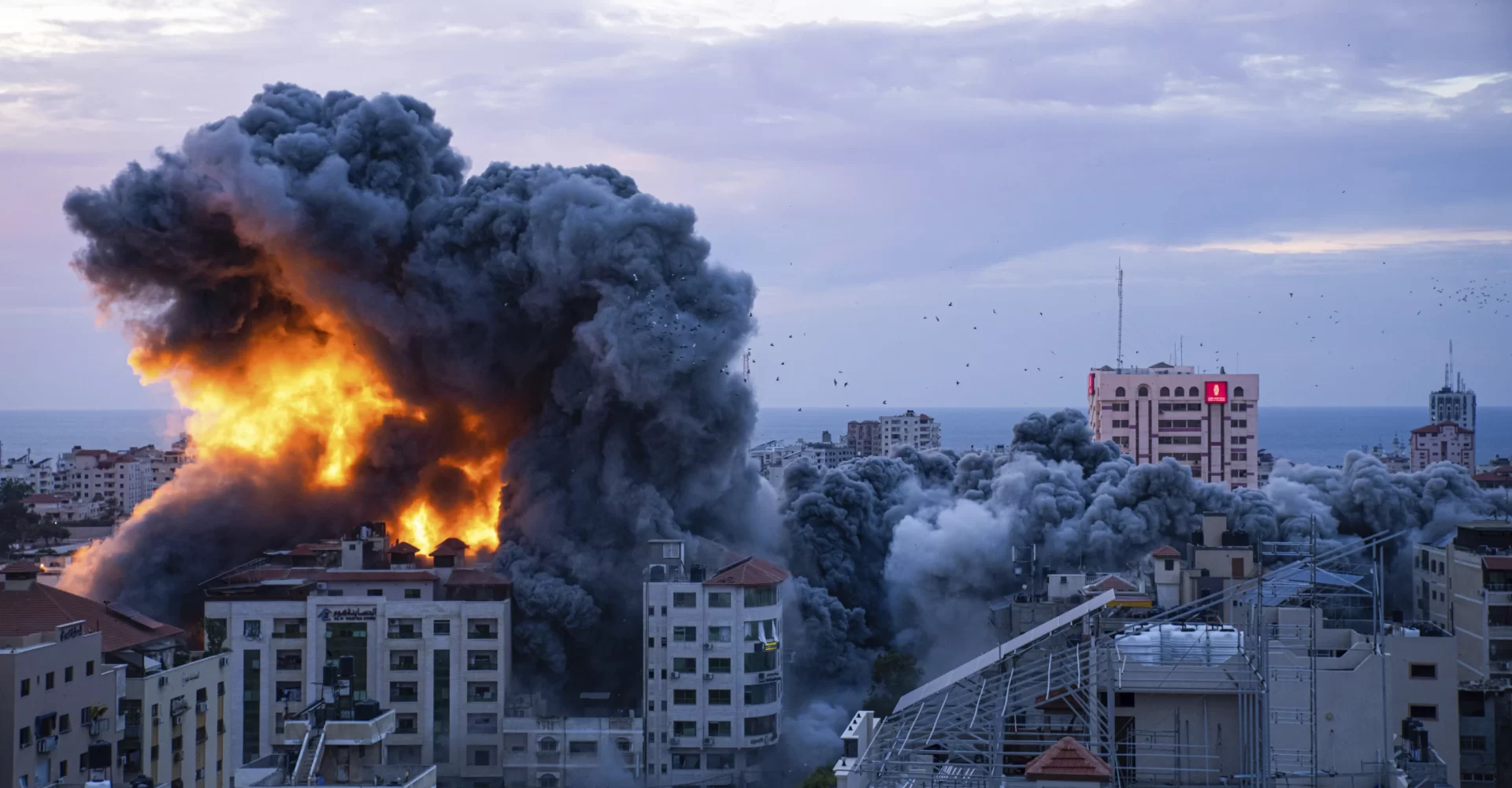DEIR AL-BALAH, Gaza Strip — Israeli fighter jets hit targets in the Gaza Strip minutes after a weeklong truce expired on Friday, as the war with Hamas resumed in full force. Black smoke billowed from the besieged territory and Israel dropped leaflets over parts of southern Gaza urging people to leave their homes, suggesting it was preparing to widen its offensive.
Renewed hostilities heightened concerns for the about 140 hostages who remain in Gaza, after more than 100 were freed as part of the truce.
The collapse of the cease-fire came a day after U.S. Secretary of State Antony Blinken met with Israeli officials and urged them to do more to protect Palestinian civilians as they seek to destroy Hamas. Blinken was on his way Friday to the COP28 climate talks in Dubai, where he was to meet with Arab and other leaders.
It was not clear to what extent Israeli Prime Minister Benjamin Netanyahu will heed the appeals of the United States, Israel’s most important ally. Netanyahu’s office said Friday that Israel “is committed to achieving the goals of the war: Releasing the hostages, eliminating Hamas and ensuring that Gaza never again constitutes a threat to the residents of Israel.”
ISRAEL-HAMAS WAR
In the leaflets it dropped in southern Gaza, Israel urged people to leave homes east of the city of Khan Younis. The leaflets also warned that Khan Younis was now a “dangerous battle zone.”
Hundreds of thousands of people fled northern Gaza earlier in the war, with many taking shelter in Khan Younis and other places in the south.
One of the first airstrikes Friday destroyed a large building in Khan Younis. Moments later, residents were seen frantically searching the rubble for survivors as medics approached. One wounded person was carried away on a stretcher.
In Hamad City, a Qatari-funded housing development near the city, a strike hit an apartment in a multi-story residential building, while other parts of the building appeared largely intact. In the refugee camp of Maghazi, rescuers clawed through the rubble of a large building hit by warplanes. A foot stuck out of the tangle of concrete and wiring.Ashraf al-Qidra, a spokesperson for the Health Ministry in Hamas-controlled Gaza, said 14 people had been killed and dozens wounded in the first hours of Israeli attacks after the truce ended.
Hamas freed eight additional Israeli hostages and Israel released another group of 30 Palestinian prisoners under a last-minute agreement to extend their cease-fire by another day in Gaza. (Dec 1)
Israel has said it is targeting Hamas operatives and blames civilian casualties on Hamas, accusing the militants of operating in residential neighborhoods. Since the war erupted Oct. 7, in response to a deadly Hamas attack on southern Israel, many of those killed in Israeli bombardments have been women and children.
In Israel, sirens warning of incoming rockets blared at several communal farms near Gaza, a sign that Hamas also resumed attacks, but there were not reports of hits or damage.
Netanyahu said the war resumed because Hamas had violated the terms of the truce. “It has not met its obligation to release all of the women hostages today and has launched rockets at Israeli citizens,” he said in a statement.
The Israeli military’s announcement of the resumption of strikes came only 30 minutes after the cease-fire expired at 7 a.m. (0500 GMT) Friday. Earlier Friday, Israel accused Hamas of having violated the terms of the cease-fire, including by firing rockets toward Israel from Gaza.
The halt in fighting began Nov. 24. It initially lasted for four days, and then was extended for several days with the help of Qatar and fellow mediator Egypt.
During the week-long truce, Hamas and other militants in Gaza released more than 100 hostages, most of them Israelis, in return for 240 Palestinians freed from prisons in Israel.
Virtually all of those freed were women and children, but the fact that few such hostages remained in Gaza made it hard to reach a deal to extend the cease-fire.
Hamas, a militant group that has ruled Gaza for 16 years, had been expected to set a higher price for the remaining hostages, especially Israeli soldiers.
It was not immediately clear whether negotiators were continuing efforts for another temporary ceasefire. Qatar and Egypt, which have played a key role as mediators had sought to prolong the truce by another two days.
On Thursday, Blinken met with Netanyahu and other top officials on his third visit to the region since the start of the war two months ago.
While expressing hope at the time that the cease-fire could be extended, Blinken said that if Israel resumed the war and moved against southern Gaza to pursue Hamas, it must do so in “compliance with international humanitarian law” and must have “a clear plan in place” to protect civilians.
He said Israeli leaders understood that ”the massive levels of civilian life and displacement scale we saw in the north must not be repeated in the south.”
Most of Gaza’s population is now crammed into the south with no exit, raising questions over how an Israeli offensive there can avoid heavy civilian casualties.
Netanyahu has been under intense pressure from families of the hostages to bring them home. But his far-right governing partners have also pushed him to continue the war until Hamas is destroyed, and could abandon his coalition if he is seen as making too many concessions.
A total of 83 Israelis, including dual nationals, were freed during the truce, most of whom appeared physically well but shaken. Another 24 hostages — 23 Thais and one Filipino — were also released, including several men.
It’s not clear how many of the remaining women hostages are soldiers.
Israel has said around 125 men are still being held hostage.
Before the cease-fire, Hamas released four hostages, and the Israeli army rescued one. Two others were found dead in Gaza.
The 240 Palestinians released so far under the cease-fire were mostly teenagers accused of throwing stones and firebombs during confrontations with Israeli forces. Several of the freed women were convicted by military courts of attempting to attack soldiers, some of them after being found carrying scissors or knives near security positions.
Hamas started the war with a deadly Oct. 7 attack on Israel, during which it and other Palestinian militants killed about 1,200 people, mostly civilians, and took around 240 people captive. Authorities have only provided approximate figures.
Since then, Israel’s bombardment and invasion in Gaza have killed more than 13,300 Palestinians, roughly two-thirds of them women and minors, according to the Health Ministry in Hamas-ruled Gaza, which does not differentiate between civilians and combatants. More than three-quarters of the population of 2.3 million have been uprooted, after weeks of Israeli bombardment and a ground campaign, leading to a humanitarian crisis.
The toll is likely much higher, as officials have only sporadically updated the count since Nov. 11. The ministry says thousands more people are feared dead under the rubble.
Israel says 77 of its soldiers have been killed in the ground offensive. It claims to have killed thousands of militants, without providing evidence.
Palestinians in Gaza have called for a permanent end to the war, saying the temporary truces don’t resolve the humanitarian catastrophe in the territory. Over 1.8 million people have fled their homes, with more than 1 million sheltering in U.N. schools and struggling to find basic items including cooking gas and flour.
AP






